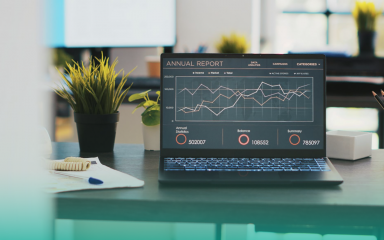How AI in Supply Chain Transformr Logistics? – Bintime
Let’s be honest – supply chains have been through the wringer. Global disruptions, unpredictable demand spikes, and an ever-growing list of customer expectations have made managing the global supply chain nearly impossible to “just wing it” anymore. So, what’s the solution? It’s not more spreadsheets. It’s AI in supply chain – and it’s already reshaping how logistics and operations work in 2025.
From smarter forecasting to automated decision-making, AI has evolved from a buzzword to a must-have. And no, we’re not talking sci-fi robots. We’re talking real tools solving real problems in real time – as you’ll see in the AI in supply chain examples we’ll cover throughout this piece.
And this isn’t a fringe movement anymore. The global AI in supply chain market is expected to skyrocket from USD 4.5 billion in 2023 to a staggering USD 157.6 billion by 2033, growing at a CAGR of 42.7%. That’s not hype – that’s an entire industry shifting gears fast, fueled by software, analytics, and digital transformation. For many companies, AI is no longer a luxury, but a tool that really helps to save money and work more efficiently.
Introduction to Artificial Intelligence
Artificial intelligence (AI) refers to the development of computer systems that can perform tasks typically requiring human intelligence, such as learning, problem-solving, and decision-making. In the realm of supply chain management, AI algorithms are a game-changer. They can analyze vast amounts of data, identify patterns, and make predictions that enhance supply chain operations. By leveraging AI, supply chain managers can make more informed decisions, reduce operational costs, and significantly enhance supply chain visibility. Imagine having a system that not only processes raw data but also provides actionable insights in real-time – that’s the power of AI in supply chains.
Benefits of AI in Supply Chain Management
If you’re thinking AI sounds promising but maybe a little “overhyped,” let’s break down what it actually does – and why it’s making supply chain execs sleep better at night. AI can enhance the efficiency of a complex supply chain by identifying inefficiencies and reducing costs associated with operating such systems. By leveraging AI, companies can achieve significant cost savings through improved efficiency and reduced operational costs.

#1. Smarter Demand Forecasting
AI systems are no longer just number crunchers. They learn from every SKU, season, promo, and even that one influencer post that suddenly spikes demand for lavender candles. Supply chain planners utilize AI to enhance demand forecasting, ensuring that inventory levels are optimized and a customer’s demand is met. By pulling information from sales history, market trends, and external factors like weather or geopolitical shifts, AI can forecast demand with scary accuracy.
The benefits of AI in the supply chain really shine here: fewer missed sales, tighter inventory, and a lot less guesswork.
That means fewer stockouts, less excess stock, and a better shopping experience for end customers – especially online, where poor availability leads to lost sales instantly.
#2. Route Optimization and Cost Reduction
It’s not just about getting things from A to B anymore; it’s about optimizing logistics networks to get them there fast, cheap, and in a way that keeps carbon footprints in check. AI-driven route optimization adapts to real-time conditions – like traffic, fuel costs, or warehouse constraints – helping logistics teams cut operating costs and emissions without compromising speed.
#3. Real-Time Visibility
The days of “we think your package is somewhere in Ohio” are over. With AI, companies can track products from factory to doorstep, giving both internal teams and customers the visibility they crave. AI systems can analyze data collected from Internet of Things (IoT) devices deployed within the supply chain. It’s not magic. It’s machine learning, sensor data, and predictive alerts working together make it easy to search inventory availability, shipment status, and warehouse data – all in real time. This level of visibility enhances supply chain transparency, ensuring that all stakeholders have access to real-time information.
#4. Faster, Smarter Risk Management
Let’s face it: delays, shortages, and supply chain disruptions aren’t going anywhere, but AI can manage these complex tasks more effectively. With AI in supply chain optimization, companies can react faster – rerouting shipments, shifting production, or sourcing alternatives automatically. It’s like having a risk radar that’s always on.
And that’s just scratching the surface of the use of AI in supply chain management – we’re talking better agility, smarter decisions, and way fewer surprises.
#5. Inventory Management
Inventory management is a cornerstone of effective supply chain management, and AI is revolutionizing this space. By analyzing historical data, market trends, and customer demand, AI knows exactly how much product you will need – neither more nor less. It studies trends and suggests what to order and when. AI-powered systems can identify the most efficient route for inventory movement, cutting transportation costs and improving delivery times. Additionally, these systems take over routine work – monitoring inventory levels, warning of possible shortages – and free up specialists’ time for more important, strategic decisions.
Key AI Technologies Transforming Supply Chains
Okay, so what’s under the hood? Not all AI is created equal. Some technologies are doing more of the heavy lifting than others.
- Machine Learning: The Brain Behind the Forecast
ML is the workhorse of AI in supply chain management. It takes historical data, adds some predictive sauce, and outputs forecasts, delivery timelines, and performance metrics. It’s used to optimize stock levels, improve online fulfillment, and even refine listings and descriptions based on real-time demand signals. Developing a comprehensive AI strategy is crucial for effectively integrating these technologies into supply chain operations.
The increased collection and use of customer data for AI models raises security and privacy vulnerabilities, emphasizing the need for businesses to prioritize consumer privacy and provide assurances about data protection.
- Computer Vision: Eyes on the Ground
Whether it’s checking if a product is labeled correctly or scanning pallets for damage, computer vision helps teams maintain quality without relying on manual checks. Tyson Foods uses it for visual inspections, catching issues before they snowball into costly recalls.
- NLP: Automating the Paper Trail
Natural Language Processing is the behind-the-scenes hero that processes documents, answers queries via chatbots, and even handles supplier emails. It doesn’t just save time – it reduces errors and keeps communications running smoothly across the board. Also pulls insights from content, such as customer service messages or product reviews, to highlight recurring supply chain issues.
- Generative AI: Scenario Planning on Steroids
Want to model a worst-case logistics scenario or test the impact of a new supplier? Generative AI in the supply chain lets teams play out “what-if” scenarios before making costly moves. It’s also being used for anomaly detection – spotting weird patterns in returns or delays before humans even notice them.
Such AI doesn’t just help – it learns, adapts, and offers solutions that people sometimes don’t think of.
AI in Supply Chain Strategy
AI solutions are not just tools; they’re strategic as AI is not just a fad. It is a smart partner that sees ahead and helps avoid chaos in supply chains.sets in supply chain management. They enhance supply chain resilience, reduce disruptions, and promote sustainability. By analyzing data from sensors, GPS, and even social media, AI helps supply chain managers identify potential risks and develop effective mitigation strategies. It optimizes supply chain operations, from demand forecasting to inventory management and logistics optimization. Moreover, AI fosters better collaboration with supply chain partners and improves transparency, ensuring that every link in the supply chain is robust and reliable.
Logistics Networks Optimization
Logistics networks optimization is a critical aspect of supply chain management, and AI is proving to be a game-changer in this domain. By leveraging AI-powered systems, supply chain managers can analyze vast amounts of data, including historical data, market trends, and real-time data, to optimize logistics networks like never before.
Imagine having the ability to identify the most efficient routes for transportation, reducing both costs and delivery times. AI can do just that. By processing real-time data on traffic conditions, fuel prices, and warehouse constraints, AI-enabled systems can dynamically adjust routes to ensure timely deliveries while minimizing operational costs.
Generative AI takes this a step further by creating new routes and schedules that enhance supply chain operations. These AI-powered simulations can model different scenarios, predicting the impact of various changes on logistics networks. This proactive approach helps in mitigating risks and improving supply chain resilience.
Machine learning models, another cornerstone of AI, continuously learn from data, refining their predictions and recommendations over time. This means that logistics providers can optimize their operations, reduce costs, and improve customer satisfaction consistently.
Moreover, AI’s role in logistics networks optimization extends to inventory management and demand planning. By accurately forecasting demand and optimizing inventory levels, AI helps in reducing excess inventory and minimizing stockouts. This not only enhances supply chain visibility and transparency but also promotes sustainability by reducing waste.
In essence, the implementation of AI in logistics networks optimization is transforming how supply chains operate, making them more efficient, resilient, and responsive to market demands.
Real-World Use Cases and Examples
The theory is good. Now let’s see how it works in practice. Who’s using AI in supply chain, and what are they getting out of it? Global supply chains are crucial logistics networks that have been impacted by various disruptions, including transportation delays and labor issues. Logistics providers are increasingly adopting AI to optimize their operations and improve service delivery.
SAP: Precision Demand Planning
SAP’s AI systems help clients adjust production and distribution plans in real-time, cutting waste and responding quickly to market shifts. With predictive modeling, teams don’t just plan – they adapt on the fly. By accurately forecasting a customer’s demand, SAP’s AI systems help companies adjust their production and distribution plans more effectively by analyzing data sets to uncover patterns that aid in decision-making processes.
UPS: Smart Deliveries and Dynamic Routing
UPS doesn’t just deliver boxes; it optimizes logistics networks with AI-optimized routes that save millions of miles each year. Their ORION system uses historical and real-time data to dynamically adjust driver routes, saving them an estimated 100 million miles annually. These optimized operations help managers actually see what’s going on across their logistics networks — and spot where things could run better. Thanks to visual models and digital twins, they can test and tweak without touching the real-world system. Yep, really.
Tyson Foods: Quality Control with Computer Vision
We mentioned Tyson earlier, but it’s worth repeating. They use computer vision systems in processing plants to detect anomalies faster than human inspectors, keeping food safer and reducing waste. Personal protective equipment (PPE) is also monitored by AI systems to ensure worker safety and adherence to safety regulations. It’s one of many AI use cases in supply chain where tech adds measurable value. AI technologies are also being used in distribution centers to enhance warehouse productivity and ensure timely deliveries.
A Broader View
From auto manufacturers using AI to schedule just-in-time parts delivery, to fashion brands using generative AI in supply chain for demand prediction across regions, examples of AI in supply chain span industries and continents. Selecting the right supply chain solutions is crucial for leveraging AI to its full potential.
So, how is AI being used in supply chain settings today? Simple – it’s optimizing forecasts, reducing waste, improving delivery times, and enhancing various supply chain activities to give companies the edge they need to keep up with rising complexity.
Generative AI Applications
Generative AI is a type of AI that creates new content based on existing data, and its applications in supply chain management are groundbreaking. Imagine a digital copy of your warehouse that shows you what’s happening in real time – and tells you how to make things even better. It can generate simulations of supply chain operations, helping to identify bottlenecks and optimize supply chain design. Generative AI doesn’t just crunch numbers – it learns from patterns, predicts what’s coming next, and helps teams stay ahead of disruptions. It also dishes out smart, tailored suggestions for supply chain managers, making decisions faster and easier. Bottom line? It gives you a real edge in managing the chaos of modern supply chains
Improved Warehouse Efficiency
AI is transforming warehouse operations by optimizing every aspect, from inventory management to order fulfillment and shipping. Warehouse operators can leverage AI technology to reduce errors and waste within manufacturing and shipping processes. By analyzing data from sensors, cameras, and wearable devices, AI identifies inefficiencies and devises strategies to boost productivity. AI-powered systems automate tasks like inventory tracking and order picking, reducing labor costs and improving accuracy. Furthermore, AI optimizes warehouse layout and design, cutting storage costs and enhancing inventory turnover. The result is a more efficient, cost-effective warehouse operation that meets customer demand with precision.
By integrating these new sections, we provide a comprehensive view of how AI is revolutionizing supply chain management, making the article more informative and engaging for readers.
Challenges to AI Adoption
So, is AI the silver bullet? Not quite. Like any tech shift, the road has a few potholes.
- Data headaches and integration nightmares. AI needs clean, reliable data – and not every supply chain has it. Old systems, siloed spreadsheets, and bad habits can get in the way. Integration is the name of the game, but it’s rarely a plug-and-play process. Implementing AI requires careful consideration of data quality and integration challenges. Before diving into AI, businesses should prepare a legacy supply chain planning and management system to assess existing challenges and bottlenecks.
- People and process pushback. Let’s be honest – change is uncomfortable. Employees might fear automation, or simply not know how to work with AI tools. Training, upskilling, and change management can’t be skipped. The tech is only as good as the people using it.
- Ethical and legal hurdles. From data privacy to algorithmic bias, the use of AI in the supply chain raises tough questions. Who owns the data? Who’s accountable when AI makes a bad call? These aren’t just legal questions – they’re ethical ones.
The Future of AI in Supply Chain
What’s next? Spoiler: it will be even more interesting.
Autonomous Planning Is Here – And It Pays Off
AI is now running real-time supply chain decisions, not just recommending them. AI-powered simulations are enabling companies to visualize potential improvements and assess operational changes without disrupting real-world processes.
McKinsey found that early adopters in the CPG space saw:
- +4% revenue
- -20% inventory
- -10% supply chain costs
But only 7% have leaped, meaning there’s still a significant first-mover advantage.
AI + IoT = Autonomous Supply Chains
Smart shelves that talk to inventory systems. Delivery trucks that plan their routes. The fusion of AI with IoT is making autonomous supply chains a real possibility. It’s not just cool – it’s efficient.
Sustainability as Strategy
AI can help companies track carbon impact, optimize packaging, and even reduce energy use across the supply chain. Green isn’t just nice-to-have anymore – it’s business-critical. And AI is how many firms are making it happen.
Getting Ready, One Step at a Time
Don’t try to do it all at once. The smartest companies start with a focused use case – maybe optimizing digital channels or automating inbound logistics – then scale what works. AI in supply chain planning is a long game, not a quick fix.
If you’re asking about the future of AI in the supply chain, it’s autonomous, connected, and hyper-efficient – built on data, driven by smart systems, and focused on results. AI also plays a crucial role in supply chain sustainability by optimizing logistics, minimizing waste, and promoting circular economies, while ensuring adherence to social sustainability standards.
Wrapping It Up
Here’s the thing: ignoring AI now is like ignoring global supply chain management in 2005. It’s not a trend. It’s the future of logistics, operations, and supply chains that actually work in 2025, outperforming non-AI systems.
Start small. Learn fast. Build smarter.











